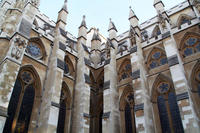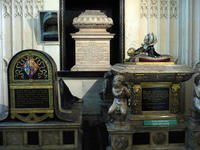You are in: Europe -> United Kingdom. England -> Westminster Palace, ... , and traditional search or Image Gallery will yield results of this site only
Westminster Palace, Westminster Abbey and Saint Margaret's Church
| Site number: | 426 |
|
| Type of site: | Cultural | |
| Date: | 11th century | |
| Date of Inscription: | 1987 | |
| Location: | Europe, UK of Great Britain and Northern Ireland, England, London, City of Westminster | |
Up to 75 images are shown here. Click on each for more details or on Image Gallery for more images.
Six official UN languages:
Arabic,
Chinese,
English,
French,
Russian,
Spanish
Other languages: Bulgarian, Catalan, Croatian, Czech, Danish, Dutch, Esperanto, Finnish, German, Hebrew, Hungarian, Italian, Japanese, Lithuanian, Norwegian-bokmål, Polish, Portuguese, Romanian, Slovak, Swedish
Other languages: Bulgarian, Catalan, Croatian, Czech, Danish, Dutch, Esperanto, Finnish, German, Hebrew, Hungarian, Italian, Japanese, Lithuanian, Norwegian-bokmål, Polish, Portuguese, Romanian, Slovak, Swedish
| Description: | Westminster Palace was rebuilt on the site of important medieval remains as of the year 1840; now it stands as an exceptional example of neo-Gothic architecture. The site is of immense historic and symbolic importance, with its tiny medieval Church of Saint Margaret, constructed in Perpendicular Gothic style, and Westminster Abbey, where the crowning of all the sovereigns has been taking place since the 11th century. --WHMNet paraphrase from the description at WHC Site, where additional information is available. | |
| Title: Westminster Abbey: The Collegiate Church of St Peter, Westminster, which is almost always referred to by its original name of Westminster Abbey, is mainly a Gothic church, on the scale of a cathedral (and served as one from 1546 - 1556), in Westminster, London, just to the west of the Palace of Westminster. It is the traditional place of coronation and burial site for English monarchs. Title: Palace of Westminster:The Palace of Westminster, also known as the Houses of Parliament or Westminster Palace, in London is where the two Houses of the Parliament of the United Kingdom (the House of Lords and the House of Commons) meet to conduct their business. The Palace lies on the north bank of the River Thames in the London borough of the City of Westminster, close by other government buildings in Whitehall. The palace is one of the largest Parliaments in the world. The layout of the Palace is intricate, with its existing buildings containing nearly 1,200 rooms, 100 staircases and well over three kilometres (two miles) of corridors. Although mainly dating from the 19th century, among the original historic buildings is Westminster Hall, used nowadays for major public ceremonial events such as lyings in state, and the Jewel Tower. Control of the Palace of Westminster and its precincts was for centuries exercised by the Queen's representative, the Lord Great Chamberlain. By agreement with the Crown, control passed to the two Houses in 1965. Certain ceremonial rooms continue to be controlled by the Lord Great Chamberlain. After a fire in 1834, the present Houses of Parliament were built over the next 30 years. They were the work of the architect Sir Charles Barry (1795-1860) and his assistant Augustus Welby Pugin (1812-52). The design incorporated Westminster Hall and the remains of St Stephen's Chapel. The exterior of the Palace of Westminster — especially the Clock Tower — is one of the most visited tourist attractions in London. The United Nations Educational, Scientific and Cultural Organization (UNESCO) classifies the Palace of Westminster along with neighbouring Westminster Abbey and St. Margaret's as a World Heritage Site. It is also a Grade I listed building. --Wikipedia. Text is available under the Creative Commons Attribution-ShareAlike License. | ||
| Source: | http://whc.unesco.org/en/list/426 | |
| Source2: | http://whc.unesco.org/en/list/426/video | |
| Reference: | 1. UNESCO World Heritage Center, Site Page. | |












































